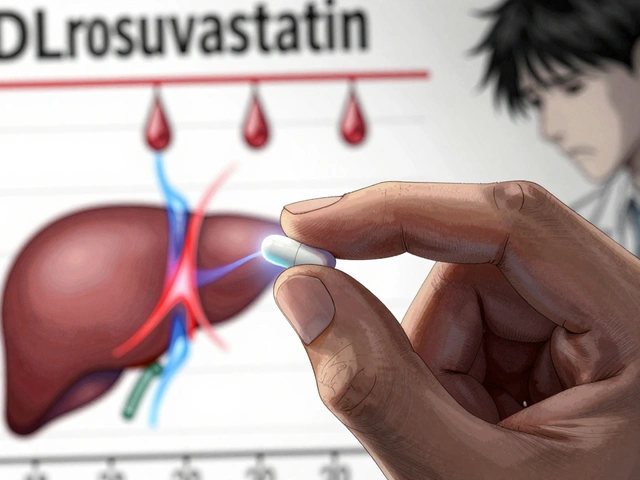Statins During Pregnancy Risk Calculator
How This Tool Works
Based on evidence from the 2015 Medicaid study and 2021 JAMA Network Open analysis, this calculator estimates your relative risk of birth defects and complications. Input your characteristics to see personalized assessment.
When a woman who needs cholesterol control discovers she’s pregnant, the first question is often the same: statins pregnancy safety. For years, doctors told patients to stop taking these drugs the moment a pregnancy was confirmed, based on animal data and a blanket FDA Category X label. In 2021, that label was softened, and a flood of observational studies has reshaped how clinicians think about the teratogenic risk and how to plan care.
Key Takeaways
- Large cohort studies (2015‑2025) show no statistically significant increase in major birth defects from first‑trimester statin exposure.
- Statins may be linked to a modest rise in preterm birth or low birth weight, but absolute risks remain low.
- Women with familial hypercholesterolemia (FH) or established atherosclerotic cardiovascular disease (ASCVD) may benefit from continuing therapy under specialist supervision.
- Pre‑conception counseling, shared decision‑making, and close monitoring are essential for high‑risk patients.
- Ongoing trials (e.g., StAmP) are testing statins for specific pregnancy complications like preeclampsia.
How Statins Work
Statins are HMG‑CoA reductase inhibitors, meaning they block the enzyme HMG‑CoA reductase that drives cholesterol synthesis in the liver. By lowering low‑density lipoprotein (LDL) cholesterol, statins reduce the risk of heart attacks and strokes.
Cholesterol is also a building block for cell membranes and fetal development, which sparked early concerns that cutting maternal cholesterol could harm the embryo, especially during neural‑tube formation.
Historical Contraindication & Regulatory Shift
Until July 2021, the U.S. FDA listed statins as Pregnancy Category X, indicating clear evidence of fetal harm. That stance was based on animal studies showing malformations at high doses.
After reviewing more than a dozen large observational studies, the FDA removed the Category X warning, stating that statins have “limited potential to cause malformations” but still recommending discontinuation in most pregnancies unless the maternal cardiovascular risk is very high.
In contrast, the European Society of Cardiology (ESC) kept a more conservative recommendation, urging clinicians to stop statins upon pregnancy detection except in “exceptional circumstances.”
Evidence From Large Cohort Studies
The 2015 Medicaid linkage study (1,152 exposed pregnancies vs 886,996 controls) reported a relative risk of congenital malformations of 1.07 (95 % CI 0.85‑1.37) after adjusting for maternal age, diabetes, hypertension, obesity, and tobacco use. The confidence interval crossed 1.0, indicating no clear increase.
A 2021 JAMA Network Open analysis of 1,443,657 pregnancies (469 statin‑exposed) echoed these findings: no rise in major birth defects, but a slight uptick in low birth weight (<2500 g) and preterm delivery (<37 weeks). The absolute increase was roughly 1‑2 % over baseline.
European data from Norway (805,368 pregnancies, 2025) found no association between first‑trimester prescription fills and any organ‑specific malformation.
A meta‑analysis of nine observational studies (Poornima et al., 2022) showed no significant link between statins and stillbirth, induced abortion, or elective abortion (all odds ratios ≈ 1.0 with wide confidence intervals).

Pregnancy Outcomes Beyond Birth Defects
While teratogenicity appears low, some studies flag other obstetric outcomes. A 2016 systematic review noted a higher rate of preterm birth among statin‑exposed women (16.1 % vs 8.5 %, p = 0.019). However, the absolute risk increase is modest, and many of those pregnancies involved women with underlying cardiovascular disease, which itself raises preterm risk.
Overall, the background risk of any major birth defect in the general population is 3‑5 %. When counseling patients, framing statin exposure as adding “no more than a 0.1‑0.2 % absolute increase in defects” helps put the numbers in perspective.
Comparing Statins to Other Lipid‑Lowering Options
| Medication | Pregnancy Category (US) | Human Teratogenic Data | Typical Use in Pregnancy |
|---|---|---|---|
| Statins | Formerly X, now not classified | Large cohort studies show no significant rise in major malformations | Considered for high‑risk FH or ASCVD under specialist supervision |
| Fibrates | C | Very limited human data; animal studies suggest possible fetal toxicity | Generally avoided; used only if benefits clearly outweigh unknown risks |
| Niacin | C | Sparse data; case reports of flushing and hepatotoxicity in pregnancy | Not recommended; lifestyle changes preferred |
| Omega‑3 fatty acids | A/B | Extensive safety data; no teratogenic signal | Often used for triglyceride control |
| Diet & exercise | Not applicable | Safe and first‑line for all pregnant women | Standard of care |
For most pregnant patients without severe dyslipidemia, the table underscores that lifestyle measures remain the safest and most effective approach.
Clinical Decision‑Making & Planning
When a woman of child‑bearing age is on a statin, the conversation should start **before conception**. A typical pre‑conception workflow looks like this:
- Review cardiovascular risk: Is she diagnosed with FH (familial hypercholesterolemia) or ASCVD? If yes, the risk of a cardiac event during pregnancy may outweigh theoretical fetal risks.
- Discuss alternatives: Can a low‑dose omega‑3 regimen, diet, or exercise meet lipid goals for the first trimester?
- Document shared decision‑making: Record indication, risk assessment, and patient preference in the medical record.
- Set a monitoring plan: If continuation is chosen, schedule monthly liver‑function tests and fetal growth ultrasounds starting at 20 weeks.
- Plan for postpartum: Evaluate the need to restart full‑dose therapy after delivery and consider breastfeeding safety.
Multidisciplinary input-cardiology, maternal‑fetal medicine, and pharmacy-improves outcomes. ACOG Practice Bulletin No. 222 (2020) stresses that “high‑risk patients should have a coordinated care plan.”

Ongoing Trials & Future Directions
The research landscape is evolving. The StAmP trial (NCT04879874) is testing pravastatin 40 mg daily from 12‑16 weeks to prevent preeclampsia in women with a history of the disorder. Preliminary phase‑2 results showed a 47 % reduction in incidence (OR 0.53, p = 0.02).
Additionally, the NIH‑funded PRESTO registry (2025‑2027) will track 5,000 pregnancies with statin exposure, providing trimester‑specific safety data that could shape future guidelines.
Regulatory bodies are taking note. The FDA’s 2023 guidance encourages developers to generate pregnancy‑safety data for drugs like statins, potentially paving the way for label updates that reflect nuanced risk‑benefit assessments.
Practical Checklist for Providers
- Identify high‑risk indications (FH, ASCVD, prior cardiac event).
- Offer pre‑conception counseling at least 3 months before planned pregnancy.
- Document informed consent, including discussion of modest preterm‑birth risk.
- If continuing statin, choose agents with the most safety data (e.g., pravastatin, rosuvastatin) and keep dose as low as clinically reasonable.
- Order baseline liver enzymes and repeat every 4‑6 weeks.
- Schedule fetal growth ultrasound at 20 weeks, then repeat as indicated.
- Re‑evaluate postpartum; encourage breastfeeding‑compatible statin if needed.
Frequently Asked Questions
Can a single accidental dose of a statin cause birth defects?
The evidence suggests that an isolated first‑trimester dose does not raise the risk of major malformations. Large databases show no signal for single‑exposure events.
Which statin has the most safety data in pregnancy?
Pravastatin and rosuvastatin have been studied most extensively in observational cohorts and are often preferred when continuation is deemed necessary.
What is the risk of stopping a statin during pregnancy for a woman with FH?
Discontinuation may raise LDL dramatically, increasing the chance of a cardiovascular event. For FH patients, the risk‑benefit balance often tips toward continued low‑dose therapy under specialist supervision.
Are there any special labs needed if a statin is continued?
Baseline liver function tests are recommended, then repeat every 4‑6 weeks. Creatine kinase is usually unnecessary unless the patient has muscle symptoms.
Do statins cross the placenta?
All statins are lipophilic to varying degrees; some cross the placenta in low concentrations. Pravastatin is the most hydrophilic, showing the least placental transfer in animal studies.











Grace Silver
25 Oct 2025 at 14:12Statins in pregnancy raise a quiet moral question about the balance between maternal health and fetal safety. The body of evidence now whispers rather than shouts. Observational data suggest no clear rise in major congenital anomalies. That invites a re‑examination of old dogma. The philosophical tension lies in weighing risk against benefit. A mother who carries a heavy cholesterol burden may suffer cardiovascular events that threaten both herself and the unborn child. To deny her a protective drug may be an injustice. Yet the placenta is a fragile interface that depends on cholesterol for development. The new studies show that the placenta may adapt. The risk of low birth weight appears modest and may be mitigated by careful monitoring. The principle of autonomy supports shared decision making. Physicians must present the evidence without alarmism. The ethical duty to do no harm must be balanced with the duty to prevent harm. In practice this means a nuanced conversation at pre‑conception. The future may bring trials that clarify whether statins could even treat pregnancy complications like preeclampsia.